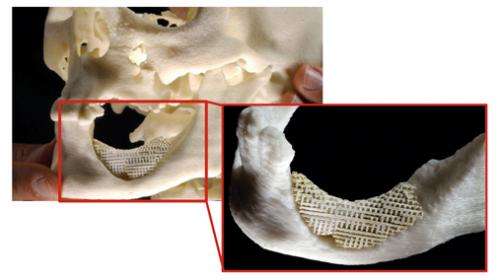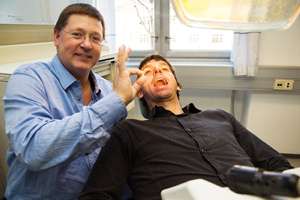Shaped scaffolding helps repair mandibular bone

A new invention made at the Faculty of Dentistry, University of Oslo, Norway, helps the body generate new bone which is as strong as the original.
The invention can save those who suffer from loose teeth and damaged mandibles. Periodontitis is a troublesome infection of the gums. When the infection causes the bone adjacent to teeth to break down, the teeth come loose. Mandibular bone can also be damaged by cancer, infections and accidents.
Using this new method, dentists can insert artificial scaffolding that will determine where the new bone tissue will grow.
To understand this method, we need to understand how bone can repair itself. After a fracture, the bone fragments can knit together only if they are in very close contact. Even if they have the ability to do this, there are major limitations. When a bone fractures, a lot of blood collects at the site of fracture. Blood contains organic molecules that coalesce into long strands. This coagulum is then populated with cells and turn into connective tissue that later calcify. The connective tissue functions as a porous growth platform for bone cells and blood vessels. The bone cells remodel the calcified structure and forms functional bone. New blood vessels help bring nutrients and oxygen.
The outer part of the bone is compact, while the inner part is porous. The porous part contains marrow cells, which are essential for maintaining the skeleton. Its porosity varies according to the type of bone.
Artificial help for bones
If there is too wide a gap between the two bone fragments, or if parts of the bone have been damaged, the body does not always succeed in repairing the damage by itself, as can happen when some of the bone has been removed during cancer surgery or when the bone has been damaged by radiotherapy.
"This is where our invention comes in," says Ståle Petter Lyngstadaas, Research Dean at the Institute of Biomaterials, Faculty of Dentistry. Along with Professor Jan Eirik Ellingsen, Associate Professor Håvard Jostein Haugen and others, Lyngstadaas has developed and patented an artificial scaffolding that help the body to repair such "critical" damage.
"With our new method, it's sufficient to insert a small piece of synthetic, bone stimulating material into the bone. The artificial scaffolding is as strong as real bone and yet porous enough for bone tissue and blood vessels to grow into it and work as a reinforcement for the new bone"
Spicing it up with stem cells
If the defect is major, the bone cells will take a long time to grow into the scaffolding.
"To speed things up, we can take bone progenitor cells or bone marrow that contain committed stem cells from the patients and insert them into the scaffolding. This will cause the process to accelerate."

"When bone needs to be built into defects where the distance between the bone fragments exceeds one centimetre or so, stem cells should be added to obtain a good result, but stem cells are normally not required to solve problems with loose teeth and periodontitis," Haugen underscores.
The bone cells are dependent on nutrients and good growth conditions and a specific signal to differentiate into bone forming cells.
"One must therefore ensure that the surrounding bone tissue is healthy, and that there is ample blood supply to the site of surgery."
Made from food additives
Manufacturing the material is a simple matter. A mixture of water and ceramic powder is poured through ultrapure foam rubber designed to look like trabecular bone. The ceramic powder consists of medical grade titanium dioxide monodisperse nano-particles. Titanium dioxide has already gone through numerous toxicity tests and is a very common additive to pharmaceuticals. The substance is also referred to as E‑171 and is widely used for colour in sweets, toothpaste, biscuits, baked goods, ice cream and cheese. When the mixture has solidified, it is heated to a temperature that causes the foam rubber to dissolve into water vapour and carbon dioxide and the nano-particles to ligate into one solid structure. The result is a mirror image of the foam rubber structure.
"The structure is similar to that of the porous part of the bone."
The material can be manufactured like cinder blocks and cut to shapes that fit into the bone defect.
The artificial bone scaffolding has an open porosity of ninety per cent containing mostly empty space that can be filled with new bone.
"A lot of empty space is important. The cavities are sufficiently large to make space not only for bone cells, but also for blood vessels that can bring in nutrients and oxygen and remove waste products. One of the big problems with current materials is that they do not provide space for both bone tissue and blood vessels."
Today: bone from cows and dead people
Today, damaged bone is repaired by removing tissue from healthy bones, e.g. from the lower jaw, shin, thigh or hip and implanting it in the damaged location. The surgery is uncomfortable and often leads to complications. When the patient's own bone tissue cannot be used, ground bone from other people can be used instead. In the USA, ground bone from deceased people is often used. Unfortunately, this solution is neither sufficiently strong, nor particularly porous. It also has the disadvantage of risk for disease transfer.
The EU and most of the world prefer a more careful solution. To avoid the risk of human disease transfer, here ground and heat-treated bone from animals are used. To avoid disease, only animals from closed and controlled herds are used. Any what source for natural bone, after removal of organics and heat treatment the porosity never amount to more than 40 percent, far below the optimum, and the material is too brittle and weak to add support to the regenerated bone.
"One of the advantages of the current methods is that the added bone is gradually devoured by the cells of the body. Our material, on the other hand, will never disappear, but always remain as an integral part of the repaired bone, working as reinforcement. This calls for higher safety requirements," Lyngstadaas explains.
Ready for clinical studies
The Norwegian dentists have tested the new method successfully on rabbits, pigs and dogs. In 2014, they wish to undertake clinical studies on patients with periodontitis and damage to the mandibular bone. To establish what method works best, it is advantageous to perform tests on patients with periodontitis in particular.
"The patients often suffer from bilateral periodontitis. This permits us to compare results by testing the material on one side and have the control on the other within in the same patient."
The dentists also hope that orthopaedists will take an interest in their new method.
"We hope to have the product on the market within a few years from now. It's a fairly large market. Many millions of kroner are spent annually on implanting new bone tissue in mandibles in Norway. Worldwide, we are talking about several million patients. We are now looking for a large industrial partner who can scale up production and bring the product to the market," says Lyngstadaas, who has co-developed the new material in cooperation with thr company Corticalis, of which he presently is the acting CEO.


















